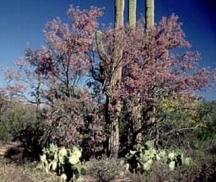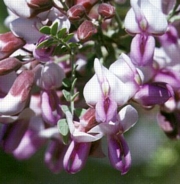

Common Names: Arizona
Ironwood, Palo-de-Hierro, Palo-de-Fierro
Genus: Olneya
Species: tesota

The desert ironwood only grows in the washes and valleys of the Sonoran Desert below 2,500 foot elevation. The Sonoran Desert is located in southwestern Arizona, southern California, and the northwestern part of Mexico. The Sonoran desert is known as a hot, dry desert. The vegetation is mostly desert scrub. The boundaries of the ironwood's habitat and that of the Sonoran desert are almost the same. Desert ironwoods are usually found in sandy washes where water is available.
Desert ironwoods are from the pea family and their leaves and flowers resemble those of the sweetpea. They're the tallest trees in the Sonoran Desert, reaching heights of 15 to 25 feet, but they can grow as tall as 30 feet. Usually they grow as small, sparse trees. They are very slow growing, with bluish gray-green leaves, and a wide, spreading crowns. They are one of the longest living trees in the Sonoran desert, and can live as long as 1,500 years, although those are very rare.
The desert ironwood, or palo fierro in Spanish, provides desert plants and animals with the food and shelter they need to survive. Its importance comes from the part it plays in the survival of over 500 plants and animals in the Sonoran Desert. As the desert ironwood grows, it alters the environment around itself, and creates a micro-habitat. Its dense canopy shades the ground under it, bringing temperatures down at least 15° F. Its seeds provide food for many doves, quail, and small rodents. Insects thrive in the ironwood canopy, which also attracts birds and reptiles. They make their home under and in the ironwood, providing prey for cactus owls, hawks and coyotes. Its nitrogen-fixing nodules on the root system, and nutrient-rich leaf litter fertilizes the soil around it. Native bees pollinate the ironwood flowers, which are also used as medicine.

The ironwood is known as a "nurse plant". It provides a safe place for seed germination, and protects seedlings from extreme cold. It also protects saplings from the damaging effects of the sun. Thorny, low-hanging branches shelter young saguaro and organ pipe cacti, night-blooming cereus, and other desert plants from browsing animals. Many wild flowers grow under the desert ironwoods, which are eaten by jack rabbits, desert bighorn sheep, Sonoran pronghorns, and mule deer. As many as 230 plant species have been recorded growing under the ironwoods.
The desert ironwood is the only member of the Olneya genus, but is part of the Fabaceae, or Pea family. Its leaves and flowers resemble those of the sweet pea. The tree usually grows from several trunks which can reach a diameter of 24 inches on very old trees.
The bark on young branches is gray and smooth. Older bark becomes wrinkled and creased, eventually shredding on older trunks. It has leathery, compound, pinnate leaves about 2 inches long with 6 to 9 leaflets about .75 inches long. The leaves are covered with fine hairs. A pair of thorns about .5 inch long grows at the base of each leaf. During the dry season the ironwoods will drop their leaves to conserve water. They never drop all of their leaves, so their canopy provides protection from frost and high heat all year round.
They bloom from April to June just before the new leaves grow back. Clusters of pea-like flowers ranging from pink, pale-rose, to white, grow in archs at the end of branches. These develop into brown, bean-like seedpods about 2 inches long. Each seedpod has 1 to 4 brown beans in it. The ironwood seeds mature at a time of year when very few plants are producing fruit. Wildlife is highly dependent on its seeds. The seeds can also be roasted and eaten, or ground into a flour.

When given enough water the desert ironwood is an evergreen tree. It is being used in landscape plantings as a shade tree. The desert ironwood is well adapted to the heat and lack of water of the Sonoran Desert however. The desert ironwood is drought deciduous, and will shed its leaves during dry periods to conserve water. This avoids loss of water through transpiration. The desert ironwood puts all of its energy towards flowering and regeneration after the spring rains . New leaves appear shortly after the tree has begun to bloom. The leaves have a soft covering of hair which protects them from damaging ultraviolet rays of the sun. The leaf litter under the tree acts as mulch and keeps the soil around the tree moist for longer periods after a rain. Sharp thorns discourage browsing by desert inhabitants.
The wood of the desert ironwood is very hard and dense. It actually sinks in water. It was used by the Seri Native Americans of Mexico for tool handles. Today the Seri Indians make carvings of desert plants and animals from the ironwood. Dead wood is gathered from the desert floor, and the carvings are made with hand tools. Tradition has it that carvings made from the desert ironwood bring good fortune and long life. The carvings are in much demand, especially large carvings, and bring in a lot of money. Illegal harvesting of ironwood is on the rise and live trees are being cut down.
Desert ironwood burns very hot and is used to make charcoal. Woodcutting causes an average of 17% reduction in ironwood. Wood has been illegally cut even in the Organ Pipe Cactus National Monument and other protected areas.
Desert ironwood trees grow only in the Sonoran desert. Urban developments are threatening their habitat. Many of Tucson, Arizona's housing developments are expanding into the ironwood forests. The destruction of the forests means the destruction of the special ecosystem the ironwoods create. The already endangered cactus pygmy owl, which depends on the ironwoods for it prey, would be in greater danger of extinction. The threatened desert bighorns and Sonoran pronghorn antelopes depend on it for forage. It would mean the disappearance of the saguaro and the pipe organ cacti which need the shade of the ironwoods when they are young. Although it doesn't look like a very important tree, in the desert the ironwood tree enables life to flourish. Without it, that life would disappear.
2002
Bibliography:
"WoodenUKnow Desert Ironwood olneya tesota(It's WOODEN, you know! ... ", http://woodenuknow.com/desertironwood.html
"Olneya Tesota . Desert Ironwood, Field Lupine. ", http://www.laspilitas.com/plants/453.htm
"Olneya tesota", http://www.winrock.org/forestry/factpub/FACTSH/O_tesota.html
"Olneya tesota Fact Sheet", http://www.cnr.vt.edu/dendro/dendrology/Syllabus2/otesota.htm
"OLNEYA TESOTA A. Gray Tesota Literature Cited", http://216.239.53.100/search?q=cache:QdK-ip7Qdn4C:wpsm.net/ Olneya%25201974.pdf+Olneya+tesota&hl=en&ie=UTF-8